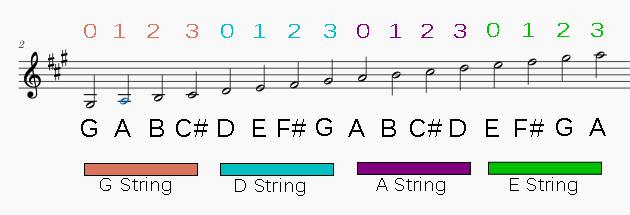Violin String Notes
This article will attempt to explain how the violin string notes work. The violin strings each have basic notes and more advanced notes, but for a beginner violinist, it’s important to understand the basic string notes and how they work with sheet music.
Your violin strings are the notes G, D, A and E. And on each one of those strings, each finger you place on a string represents another note. I highly suggest that you have a look at my article on finger positions to familiarize yourself with the violin finger positions before attempting to understand the violin string notes and how to read them.
The notes on the music scale are written in the trebble cleff, and for a basic violin lesson, in D Major. The violin string notes will therefore look like this on paper except that there are two sharps, not three:

Each string’s finger position has been marked above the note. So for the G String, you will have G, A, B and C# (keeping in mind that the basic violin scale is in D major. D major has two sharps. The image shows it as three sharps, but take the G sharp out, it’s only F and C sharp that you need to deal with.
For D, you have D, E, F# and G. In the same way, you can read the other two string notes. There are more notes on each string, still following the basic violin scale, but those are notes in position which we will not deal with in this article. For all our purposes, the notes we are dealing with here are for the first position of the violin.
It is also important to note that the music stave has lines and spaces. Therefore, some of your notes fall on lines, and other s fall on spaces. An easy way to remember which notes are on the lines are to say the sentence “Eat good bread dear father” and the spaces being “F A C E spells Face”. That way, if you need to know which note is on the third line, you just say the sentence, counting from the bottom line as you go, “eat good bread”. The third line falls on B for bread, therefore the third line’s note is bread.
Those are the violin string notes. for more info on these, please remember to go to my YouTube channel or browse my articles about this topic on violin string notes. It is important to grasp the violin string notes before embarking on playing the violin.







